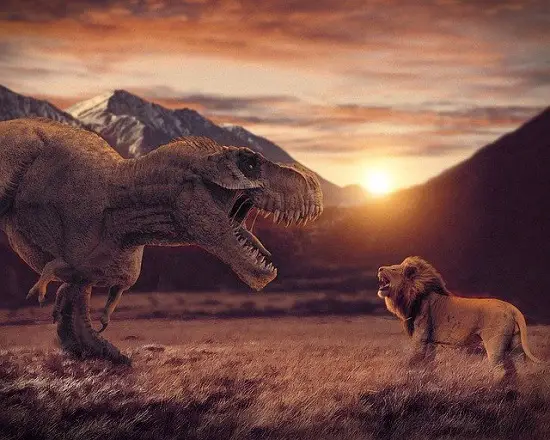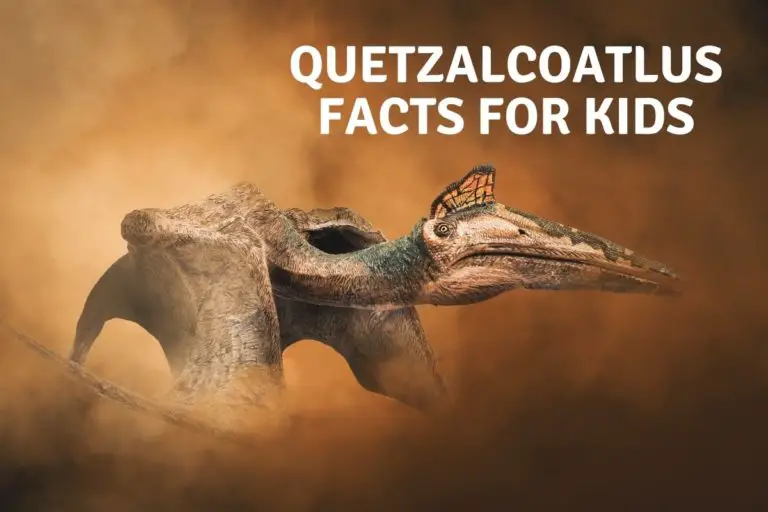12 Most Popular Long Neck Dinosaurs
Long neck dinosaurs, or sauropods to give them their proper names are the largest animals to ever walk on earth. Although known for their size not all Sauropods were huge, and some looked quite different to most people’s expectations. We take a look at the huge long neck dinosaurs of courses, but also at the weird and wonderful sauropod species that are ever popular with dinosaur fans.
In this article, we’ll explore 12 of the most popular long-necked dinosaurs, each with its own distinct characteristics that make them stand out among their prehistoric peers. Although there are plenty more to look at these are our personal favourites from the sauropod / long neck dinosaurs.
What is a Long Neck Dinosaur
A long neck dinosaur, is officially named as a sauropod, is a type of herbivorous dinosaur characterized by its colossal size, long neck, and equally lengthy tail. These prehistoric giants dominated the Jurassic and Cretaceous periods, their size keeping them safe, mostly, from the jaws of predators – at least when they were full sized.
Their long necks allowed them to reach high into the treetops for vegetation and food, while their massive bodies were supported by thick legs. Sauropods are the largest animals to have ever lived on land and remain some of the most popular dinosaurs ever. We have split them into the biggest, coolest and then the weirdest sauropod dinosaurs.
The 12 Most Popular Long neck Dinosaurs
The Biggest Long Neck Dinosaurs
We have some of the biggest of the long neck dinosaurs in this section, including the longest of longest necks of all of them which we start with the Mamenchisaurus.
Mamenchisaurus
The Mamenchisaurus is currently thought due to recent studies, to be the longest of the long neck dinosaurs that lived during the Late Jurassic period, approximately 160 to 114 million years ago. This massive sauropod measured up to 85 feet (25 meters) in length, with its incredibly long neck accounting for almost half of its total length at around 49 feet (15 meters).
Even more recently this may be pushed to 115 feet in total length with the two back bones being studied at the moment. Either way The Mamenchisaurus was one of the longest necked dinosaurs known to exist. Imagine how far the food had to travel down that long neck!
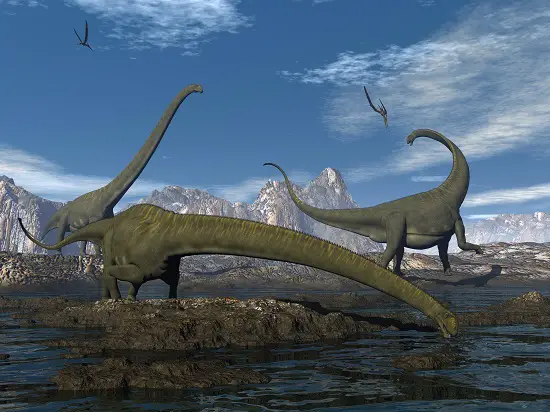
The Mamenchisaurus’s long neck allowed it to reach both high and low trees and bushes without needing to move its massive body. Its small head housed peg-like teeth, which were well-adapted for stripping leaves from branches. It also had slightly longer front legs than back getting that head even higher!
it may have even been able to walk on two legs ( although slowly) which would certainly have made it the tallest ever dinosaur – can you imagine!
many more fossils have been found and assigned to different species of Mamenchisaurus but we are looking at the largest of them here the Mamenchisaurus Sinocandorum
Cool Fact: The first Mamenchisaurus fossil was discovered by chance in 1952 during the construction of a bridge in Sichuan, China.
Mamenchisaurus Quick Facts Table:
| Long Neck Dinosaur | Length | Weight | Height | Time Period | Location |
|---|---|---|---|---|---|
| Mamenchisaurus | Up to 115 feet (35 meters) | 60 -80,000 kg, (130-180,000 lbs) ( biggest species) | 18 feet (5.5 meters) at the shoulder | Late Jurassic and early cretaceous 160 to 114 million years ago | Asia (Sichuan in China) |
Argentinosaurus
The Argentinosaurus is a truly huge long neck dinosaur that roamed South America during the Late Cretaceous period, around 97 to 93.5 million years ago. As one of the largest dinosaurs ever discovered, the Argentinosaurus could grow up to 100 feet (30 meters) long and weigh an incredible 60 to 100 tons. It is thought to likely be the largest long necks dinosaur (sauropod) ,with tails to match, to have lived ever.
Its massive size, which we have its own article on here on the site, allowed it to easily access vegetation that other herbivores could not reach, giving it an advantage against other dinosaurs and making it one of the tallest animals ever.
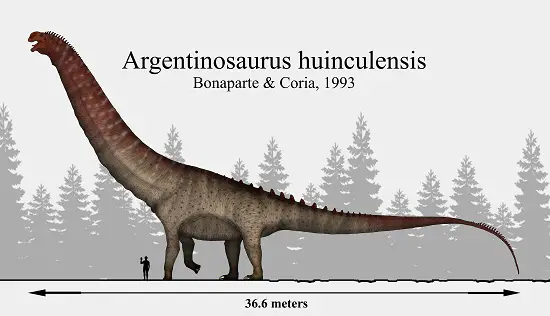
The Argentinosaurus had a long neck, though not quite as long as Mamenchisaurus above, a small head with a relatively large brain, and sturdy limbs to support its tremendous weight. Its teeth were spatula-shaped, which were well-suited for stripping leaves from branches.
Cool Fact: The Argentinosaurus laid eggs that were about the size of a soccer ball, which is relatively small considering its massive body size, still make a very large omelet though!
Argentinosaurus Quick Facts Table:
| Long Neck Dinosaur | Length | Weight | Height | Time Period | Location |
|---|---|---|---|---|---|
| Argentinosaurus | Up to 100 + feet (30 + meters) | 60,000 -100,000 kg (130-220,000 lbs | 36 feet (12 meters) at the shoulder | Late Cretaceous, 97 to 93.5 million years ago | South America (mostly in Argentina) |
Patagotitan
The Patagotitan is another colossal long neck dinosaur that lived during the Late Cretaceous period, approximately 100 or so million years ago. This gigantic sauropod measured up to 122 feet (37 meters) in length and its eight has upper estimates of over 70 tons, making it one of the largest long-necked dinosaurs ever discovered.
The Patagotitan’ s massive size allowed it to easily access vegetation high up in trees and in fact close to where its fossils were found there were fossilized trees about 15 metres tall ( 50 feet) Those long necks would come in useful for that!
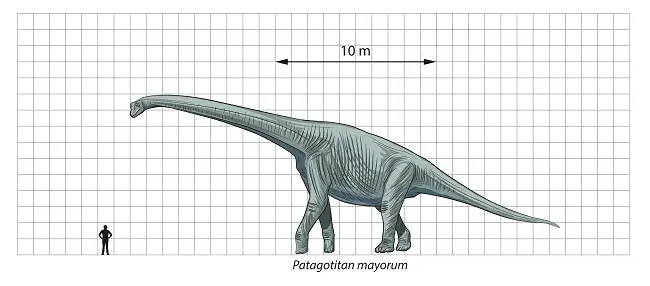
The Patagotitan had a long neck and tail, with a relatively small head and spoon-shaped teeth for efficiently stripping foliage from branches. Its sturdy limbs were well-suited for supporting its enormous body weight and at 70,000 kg you can see why.
As you can probably guess by its huge size and long neck its closest relative was in fact the Argentinosaurus above.
Cool Fact: The Patagotitan is also known as the “Patagonian Titan” due to its massive size and the region in which it was discovered – Patagonia, Argentina.
Patagotitan Quick Facts Table:
| Long Neck Dinosaur | Length | Weight | Height | Time Period | Location |
|---|---|---|---|---|---|
| Patagotitan | 122 feet (37 meters) | 57 to 80,000 kg (130 – 180,000 lbs.) | 23 feet (7 meters) at the shoulder | Late Cretaceous, 102 100 million years ago | South America (Again in Argentina) |
Barosaurus
The Barosaurus is a giant long-necked dinosaur that lived during the Late Jurassic period, approximately 150 or so million years ago. This gigantic sauropod measured up to and over 85 feet (26 meters) in length and weighed around 44,000 lbs. (20,000 kg) making it lighter than other long neck dinosaurs like Mamenchisaurus and Argentinosaurus
The Barosaurus possessed several unique features, including an elongated neck and a relatively lighter build compared to other sauropods, however there is a fossil being studied (called BYU 9024) which is a back bone or vertebra that if assigned to a Barosaurus would make it over 157 feet in length! We have an article on the biggest long neck dinosaurs here on the site.
It even would challenge the Mamenchisaurus for the title of longest neck dinosaur with a neck of over 49 feet. We will update once the studies are finished.
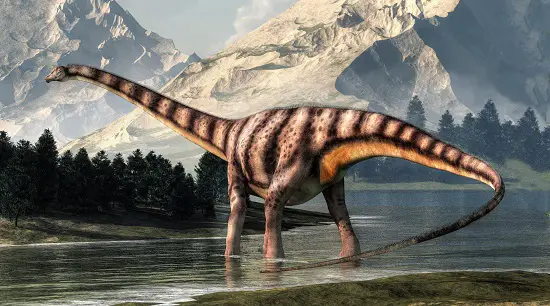
The Barosaurus is closely related to the Diplodocus and shares some similar characteristics, such as the peg-like teeth, and although it also had a long neck and long tail, its neck was longer and its tail was shorter than its relative the diplodocus.
Cool Fact: A famous exhibit at the American Museum of Natural History features a dramatic Barosaurus skeleton rearing up on its hind legs to protect its young from an attacking Allosaurus.
Barosaurus Quick Facts Table:
| Long Neck Dinosaur | Length | Weight | Height | Time Period | Location |
|---|---|---|---|---|---|
| Barosaurus | 85 feet (26 meters) | 20, 000 kg (44,000 lbs.) | 15 feet (4.6 meters) at the shoulder | Late Jurassic, 150 million years ago | North America |
Dreadnoughtus
The Dreadnoughtus is a long-necked dinosaur that lived during the Late Cretaceous period, approximately 77 to 70 million years ago. This colossal sauropod measured up to 85 feet (26 meters) in length and although tis weight is still disputed was likely up to and over 50 tons.
The Dreadnoughtus is one of the largest and most complete of the long-necked dinosaurs ever discovered, and its sheer size likely provided it with some protection against predators.( making its name more than suitable)

Tike the other long neck dinosaurs ( sauropods) The Dreadnoughtus had a long neck and tail, with a relatively small head. The fossil discovered was not yet fully grown and there are still studies to assess how large it would have been if it had grown full size.
its neck was over 12 metres ( 37 feet long) making it one of the longest necks of all the sauropods as well.
Cool Fact: The Dreadnoughtus’s name means “fears nothing” in reference to its massive size, which would have made it virtually invulnerable to predators.
Dreadnoughtus Quick Facts Table:
| Long Neck Dinosaur | Length | Weight | Height | Time Period | Location |
|---|---|---|---|---|---|
| Dreadnoughtus | 85 feet (26 meters) | 40-50,000 kg (90-110,000 lbs.) | 20 feet (6 meters) at the shoulder | Late Cretaceous, 77-70 million years ago | South America (Argentina) |
The Coolest Long Neck Dinosaurs
From movies to names we have of the most famous and coolest of the sauropods here in this list, starting with the most famous of them all the Brachiosaurus.
the Brachiosaurus
The Brachiosaurus is a remarkable long-necked dinosaur that lived during the Late Jurassic period, approximately 154 to 150 million years ago. It is famous for appearing in Jurassic Park Series of movies, and was the second dinosaur to be seen in the movie (after a few glimpses of a velociraptor) That’s why we have it in our coolest long neck dinosaur section!
The Brachiosaurus could grow up to 70 to 85 feet (26 meters) long, with its neck alone reaching lengths of 30 feet (9 meters). Its front legs were longer than its back legs, giving it a unique, giraffe-like posture (no relation!) its weight estimates go to around 40, 000 kg ( 88,000 lbs.) making it huge but not the biggest sauropod out there.
Although, kinda cute, it would have had to have a big heart to pump blood up that long neck, possibly up to 880 lbs. of heart!
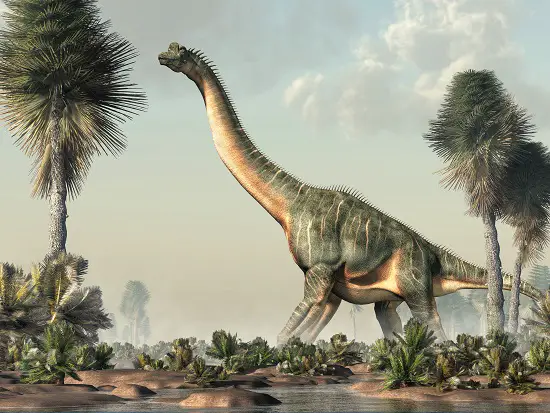
The Brachiosaurus like sauropods and a broad, thick skull with spoon-shaped teeth for efficiently stripping foliage from branches, and has been suggested that it had nostrils on top of its head, or near it, to help it drink with out its nose in the water!
Cool Fact: The Brachiosaurus gained widespread recognition and popularity after its appearance in the 1993 blockbuster film, Jurassic Park.
Brachiosaurus Quick Facts Table:
| Long Neck Dinosaur | Length | Weight | Height | Time Period | Location |
|---|---|---|---|---|---|
| Brachiosaurus | Up to 70 – 80 feet (22 -24 meters) | 40,000 kg (90,000 lbs.) | 30 -43 feet (9 – 13 meters) | Late Jurassic, 154 to 150 million years ago | North America |
Apatosaurus
The Apatosaurus, once known as Brontosaurus, so famous for 2 names! is one of the most iconic long-necked dinosaurs that inhabited North America during the Late Jurassic period, around 150 million years ago.
Although part of this fame is being known by two well known names it has also become a staple of the Jurassic Park movies like the brachiosaurus, so this automatically gives them cool points even if it was smaller than a lot of more famous sauropods (long neck dinosaurs)
This still massive long necked dinosaur grew up to 75 feet (23 meters) long and weighed approximately 20-25 tons. With some up to 32 tones ( 32,000 kg) The Apatosaurus like its relation the Diplodocus also had whip-like tail, which some scientists speculate was used for defense against predators or communication with other members of its species.
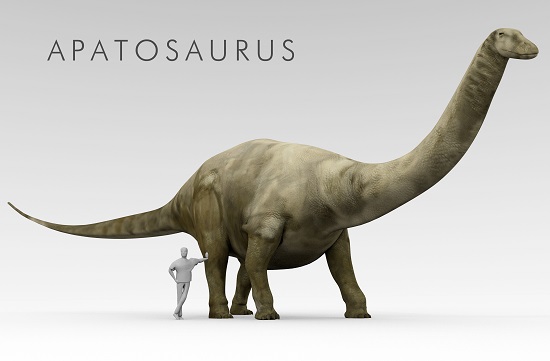
Despite still being large it is thought that these sauropods were actually much faster than their larger cousins, and speeds of 20-30 kilometres have been suggested. As the adage goes
We don’t have to be faster then the Allosaurus, we just have to be faster than you!
We may have adapted it a little! It did however live with Allosaurus in the same area at the same time.
Cool Fact: In 1903, paleontologists discovered that the Apatosaurus and Brontosaurus were actually the same dinosaur, with Apatosaurus being the correct name due to its earlier discovery. However, the name “Brontosaurus” persisted in popular culture for many years before the scientific community fully accepted the change.
Apatosaurus Quick Facts:
| Long Neck Dinosaur | Length | Weight | Height | Time Period | Location |
|---|---|---|---|---|---|
| Apatosaurus | Up to 75 feet (22 -24 meters) | 20-25,000 kg (40-60,000 lbs.) | 15 feet (4.5 metres) | Late Jurassic, 152 to 150 million years ago | North America |
The Diplodocus
The Diplodocus is another well-known long neck dinosaur that roamed the Earth during the Late Jurassic period, about 154 to 152 million years ago. it is particularly famous in the UK for its almost permanent display in the Natural History Museum in London, and has given countless childres, me included a long time ago, first taste of the size of dinosaurs. This makes it my personal Coolest long neck dinosaur. Her ( i think) name is Dippy the Diplodocus.
This sauropod (long neck dinosaur) was characterized by its long tail, which contributed to its astounding total length of up to 90 feet (27 meters). This whip-like tail was exceptionally long, making up more than half of its overall length.

Interestingly, the Diplodocus had shorter forelimbs than hind limbs, unlike a brachiosaurus for example. Although plenty long enough now when the second species of diplodocus was described it was estimated at 171 feet long…… however this was scaled down dramatically (every one wants to find the next biggest dinosaur!)
Even so it does have a hugely long tail perhaps twice as long and much more flexible than many other long neck dinosaurs and although this has been found no evidence remains of the head have ever been found.
Cool Fact: Diplodocus fossils as well as vertebrae have been found with preserved skin impressions, revealing that these dinosaurs had a row of spines running along their back and tail up to 7 inches long.
Diplodocus Quick Facts Table:
| Long Neck Dinosaur | Length | Weight | Height | Time Period | Location |
|---|---|---|---|---|---|
| Diplodocus | up to 90 feet (27 metres) maybe more | 10 – 15,000kg (22 – 30,000 lbs) | 15 feet (4.5 metres) | Late Jurassic, 154 to 152 million years ago | North America |
Giraffatitan (formerly Brachiosaurus)
Honestly, the Giraffatitan is on our list of coolest long neck dinosaurs mainly due to its name. However, it was a very large sauropod that lived during the Late Jurassic period, approximately 150 million years ago.
This colossal sauropod was at first considered to be a species of Brachiosaurus, but later studies identified it as a distinct species. The Giraffatitan measured up to 74 feet (22.5 meters) in length and weighed around 25 to 39 tons. that’s a lot of vertebrae to count.
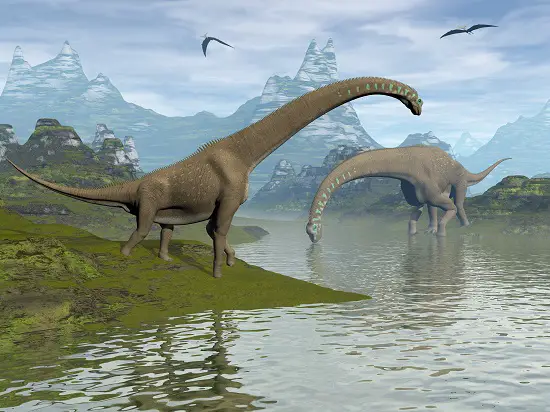
Like the Brachiosaurus, the Giraffatitan had a distinctive vertical neck position and longer front legs than back legs making it look, like brachiosaurus similar to a giraffe. The Giraffatitan fossils have been found in Tanzania,
Cool Fact: The Giraffatitan’s name means “giant giraffe” in reference to its giraffe-like posture and browsing habits.
Giraffatitan Quick Facts Table:
| Long Neck Dinosaur | Length | Weight | Height | Time Period | Location |
|---|---|---|---|---|---|
| Giraffatitan | 74 feet (22.5 meters) | 25-39 tons | 30+ feet (9 meters) at the shoulder | Late Jurassic, 150 – 145 million years ago | Africa (primarily in Tanzania) |
The Weirdest Long Neck dinosaur
While all Sauropods were the same basic body shape there did not all look the same. below we look at three of the most unusual, one with a vacuum type mouth, a small armored sauropod and a spiky armored long neck dinosaur!
Amargasaurus
The Amargasaurus one of the more unique long neck dinosaurs (sauropod) on the list that lived during the Early Cretaceous period, approximately 129 to 122 million years ago. Its uniqueness comes from not only its size but the spikes or sail (depending whose research and how old it is) that go all the way down its neck and vertebrae.
This smaller sauropod measured around 33 to 43 feet (9 to 13 meters) in length and weighed roughly 5 tons. Its most striking feature was the presence of elongated spines on its neck, which are now thought to have formed a double row of tall, sail-like structures.
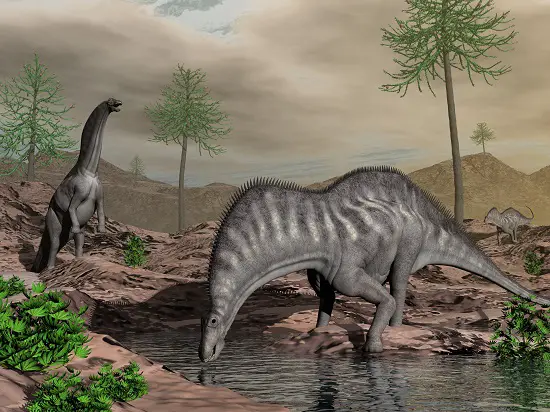
The function of the spines or sail on Amargasaurus is still being debated among paleontologists. Some suggest that the spines may have been a skin sail used for controlling body temperature, while others believe the spines could have been used for display or defense.
Cool Fact: The Amargasaurus is named after the La Amarga Formation in Argentina, where its fossils were first discovered in 1984.
Amargasaurus Quick Facts Table:
| Long Neck Dinosaur | Length | Weight | Height | Time Period | Location |
|---|---|---|---|---|---|
| Amargasaurus | 33 feet (10 meters) | 5,000 kg (11,000 lbs.) | 10 feet (3 meters) at the shoulder | Early Cretaceous, 129 to 122 million years ago | South America |
Magyarosaurus
The Magyarosaurus is one of, if not the, smallest sauropods (long neck dinosaur) that lived in madagascar during the Late Cretaceous period, approximately 71 to 66 million years ago.
This tiny dinosaur, for a sauropod, measured only around 19.5 feet (6 meters) in length and weighed about 1 ton, making it one of the smallest known long-necked dinosaurs with small vertebrae. Although that size is certainly unusual, it may not be the most unusual feature of this dinosaur.
The Magyarosaurus had several fascinating features, including bony armor plates called osteoderms, which were embedded in its skin.
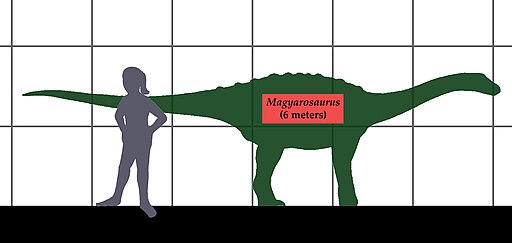
The presence of armor in Magyarosaurus suggests that it it did need projection from some predators. It lived with Elopteryx which could have been up to 2 metres tall. Not much of a threat on its own, but if it was a pack hunter then maybe that armor would have come in useful.
Cool Fact: The Magyarosaurus was named in honor of the Hungarian paleontologist Franz Nopcsa, who studied the fossils found in what is now modern-day Romania.
Magyarosaurus Quick Facts Table:
| Long Neck Dinosaur | Length | Weight | Height | Time Period | Location |
|---|---|---|---|---|---|
| Magyarosaurus | 19.5 feet (6 meters) | 2,000 lbs. (1000kg) | 6.5 feet (2 meters) at the shoulder | Late Cretaceous, 70 to 66 million years ago | Europe ( in Romania) |
Nigersaurus
The Nigersaurus is a still classed as a long neck dinosaur even though it is much smaller than most other sauropods. It lived during the Early Cretaceous period, approximately 115 to 105 million years ago.
This distinctive sauropod measured around 30 feet (9 meters) in length and weighed about 4 tons the same as an elephant today, although that is unusual it is not unique, that falls to its a unique, wide, shovel-shaped jaw with over 500 small, sharp teeth, which allowed it to efficiently graze on low-lying vegetation and of course the neck that allowed it to get up high if it needed to.
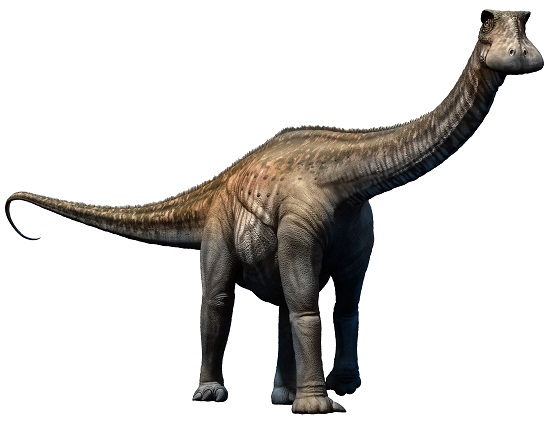
The Nigersaurus had a relatively short neck compared to other sauropods, and its skull was uniquely structured, with large openings that reduced its weight which if lowering it to feed would be very useful.
as long as it didn’t lower it near water that is, as this long neck dinosaur lived along side huge crocodiles like Sarcosuchus and theropods like Kryptops.
Cool Fact: The Nigersaurus has been nicknamed the “Mesozoic cow” due to its specialized jaws and teeth, which were adapted for ground-level grazing like modern-day cows.
Nigersaurus Quick Facts Table:
| Long Neck Dinosaur | Length | Weight | Height | Time Period | Location |
|---|---|---|---|---|---|
| Nigersaurus | 30 feet (9 meters) | 4 tons | 8 feet (2.4 meters) at the shoulder | Early Cretaceous, 115 to 105 million years ago | Africa |
We also have an article on the cutest dinosaurs if you want the other end of the story as well!
Conclusion
This was a long article so we will keep the conclusion thankfully short. There are plenty of sauropods currently discovered, and there are some of our favorites for many reasons, from the feeling when we saw the Brachiosaurus in Jurassic Park, or the first time i saw the Diplodocus skeleton in London,
These huge long neck dinosaurs hold a special place in most dino lovers hearts and with their incredible size that’s as it should be!
References
- https://www.nhm.ac.uk/discover/what-is-the-biggest-dinosaur.html
- https://abcnews.go.com/US/species-dinosaurs-found-china-scientists/story?id=79380332
- https://www.sciencefocus.com/nature/17-of-the-weirdest-dinosaurs-to-walk-the-planet/
- https://edition.cnn.com/2023/03/15/world/dinosaur-with-record-long-neck-scn/index.html
- https://www.nhm.ac.uk/discover/news/2023/march/longest-ever-necked-dinosaur-discovered-in-china.html
- https://sciencing.com/list-longnecked-dinosaurs-8078579.html
- https://newatlas.com/science/dinosaur-50-ft-neck-longest-animal
Hi, I am Roy Ford a General Studies and English Teacher who has taught all over the world. What started as a fossil collection became a great way to teach, motivate and inspire students of all ages and all over the world about dinosaurs and from that and children’s love of dinosaurs came the site dinosaur facts for kids, a resource for all ages.


